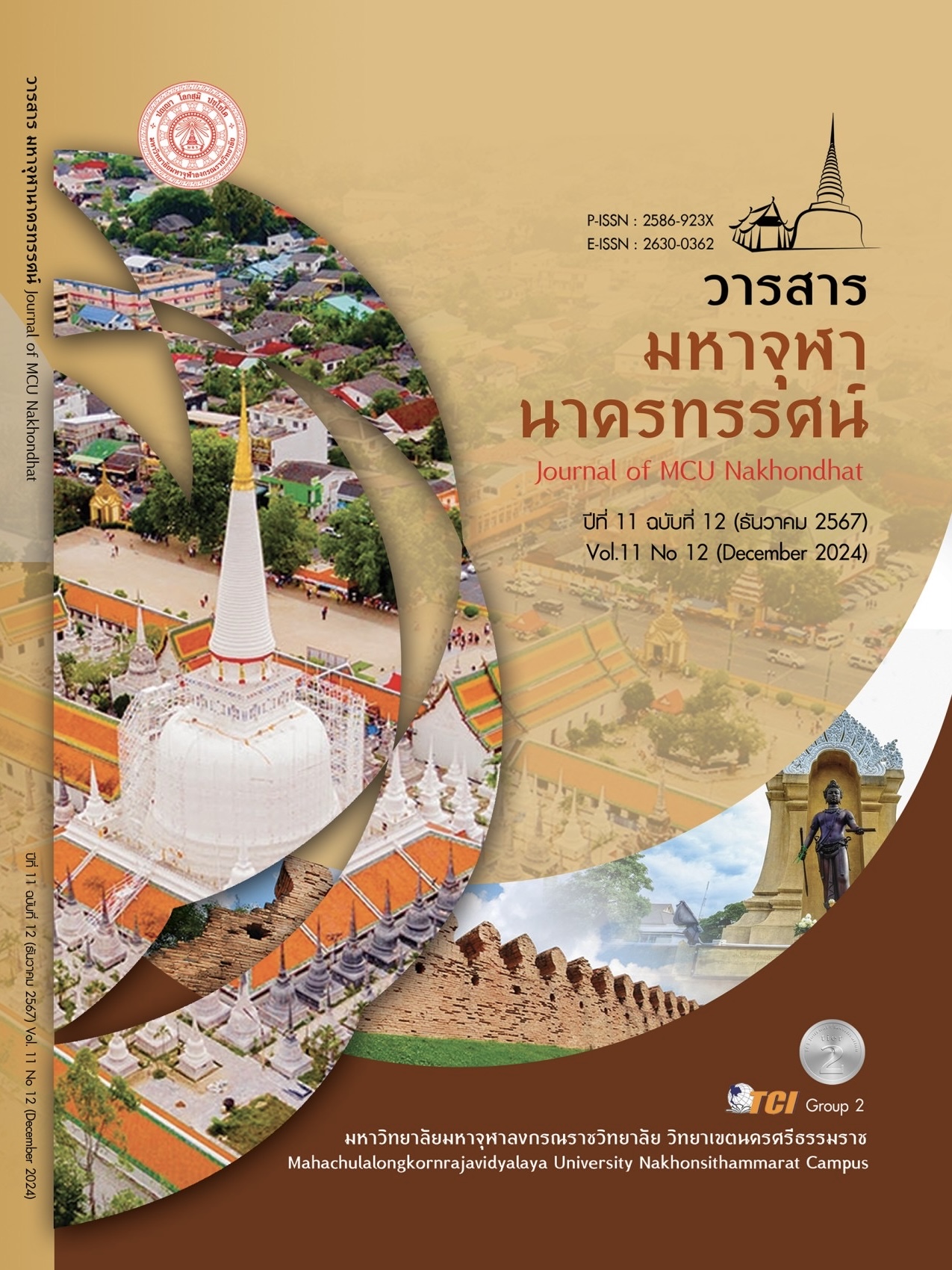THE DEVELOPMENT OF AN INTEGRATED DANCE LEARNING MANAGEMENT MODEL USING MICRO LEARNING TO PROMOTE CRITICAL THINKING SKILL IN 21st CENTURY FOR STUDENTS IN GRADE 5, WIENGSA SCHOOL, SURATTHANI PROVINCE
Main Article Content
Abstract
This article of this study was: 1) Study the current situation, problems and needs of dance learning management, 2) Create and develop a dance learning management model, 3) Experiment with dance learning management model, and 4) Evaluation of an integrated dance management model using micro learning to promote critical thinking skills in 21st century for student in grade 5, Wieng sa School, Suratthani Province. This was integrated research design for mixed method is divided into 2 steps: quantitative using questionnaires, sample group includes: M. 5/3, 5/4 of 90 peoples. By using for analyzed percentage, mean, standard deviation. And qualitative In-depth interviews by purposive sampling were key informants such as: 1) Executives, 2) Dance teachers, 3) Academics, and 4) Students of 12 peoples. By analyzing the content and summarizing. The research was found that: 1) The current situation the situation is moderate ( = 3.66, S.D. = 0.43), problems overall situation is moderate (
= 3.41, S.D. = 0.75), and needs the high level (
= 4.46, S.D. = 0.56), 2) The results of the creation and development of dance learning management model, the overall evaluation results are at the highest level (
= 4.59, S.D. = 0.49), 3) The experimental result model showed that the experimental group was higher than the control group (
2 = 35.70, S.D. = 4.54), (
2 = 21.57, S.D. = 4.28), Integrated thinking (
2 = .88, S.D. = 4.79), (
2 = 24.24, S.D. = 4.30), Practical skills (
2 = 36.76, S.D. = 4.60), (
2 = 29.64, S.D. = 4.44), and 4. The evaluation results of the use of learning management formats were found to be appropriate in terms of format, steps, processes, feasibility, correctness, comprehensiveness, and usefulness at the highest level (
= 4.59, S.D.= 0.67)
Article Details

This work is licensed under a Creative Commons Attribution-NonCommercial-NoDerivatives 4.0 International License.
References
กระทรวงศึกษาธิการ. (2553). หลักสูตรแกนกลางการศึกษาขั้นพื้นฐาน พุทธศักราช 2551. (พิมพ์ครั้งที่ 3). กรุงเทพมหานคร: โรงพิมพ์ชุมนุมสหกรณ์การเกษตรแห่งประเทศไทย จำกัด.
การศึกษา 4.0. (2566). ยุคแห่งการเรียนรู้เพื่อสร้างสรรค์นวัตกรรม. เรียกใช้เมื่อ 12 ตุลาคม 2566 จาก https://shorturl.asia/VXKLN
แก้วตา เจือนาค และอารีย์ วรเตชะคงคา. (2560). การออกแบบการเรียนรู้เพื่อศตวรรษที่ 21. ใน งานประชุมวิชาการระดับชาติ ครั้งที่ 9. มหาวิทยาลัยราชภัฏนครปฐม.
ณัฐดนัย เนียมทอง. (2567). มองเทคโนโลยีเพื่อการศึกษาในยุคดิจิทัล (คลังความรู้). เรียกใช้เมื่อ 22 มกราคม 2567 จาก https://www.scimath.org/article-technology/item/8477-2018-07-18-04-11-25
บุญชม ศรีสะอาด. (2556). วิธีการทางสถิติสำหรับการวิจัย เล่ม 2. กรุงเทพมหานคร: สุวีริยาการพิมพ์.
บูรณาการการเรียนรู้ในศตวรรษที่ 21. (2566). บูรณาการการเรียนรู้ในศตวรรษที่ 21. เรียกใช้เมื่อ 15 ตุลาคม 2566 จาก https://www.starfishlabz.com/blog/249-บูรณาการการเรียนรู้ในศตวรรษที่-21
ปรัชญา ซื่อสัตย์. (2563). การพัฒนาชุดกิจกรรมพัฒนาผู้เรียนโดยใช้การจัดการเรียนรู้ตามแนวคิด STEAM ร่วมกับโครงงานเป็นฐาน เพื่อส่งเสริมความเป็นนวัตกรและผลงานสร้างสรรค์หุ่นกระบอกสำหรับนักเรียนชั้นมัธยมศึกษาตอนต้น. ใน วิทยานิพนธ์ศึกษาศาสตร์มหาบัณฑิต สาขาหลักสูตรและการสอน. มหาวิทยาลัยศิลปากร.
โรงเรียนเวียงสระ. (2567). ข้อมูลนักเรียนโรงเรียนเวียงสระ. สุราษฎร์ธานี: ฝ่ายวิชาการ โรงเรียนเวียงสระ.
ศยามน อินสะอาด. (2561). การออกแบบบทเรียนอีเลิร์นนิงเพื่อพัฒนาทักษะการคิดขั้นสูง. กรุงเทพมหานคร: ซีเอ็ดยูเคชั่น.
สำนักงานสภาพัฒนาการเศรษฐกิจและสังคมแห่งชาติ. (2561). แผนการปฏิรูปประเทศด้านการศึกษา. กรุงเทพมหานคร: สำนักงานเลขานุการของคณะกรรมการปฏิรูปประเทศ.
Cronbach, L. J. (1990). Essentials of psychological testing. (5th ed.). New York: Harper Collins. Publishers.
Krejcie, R. V. & Morgan, D. W. (1970). Determining sampling size for research activities. Educational and Psychological Measurement, 30(1), 607-610.
Likert, R. (1967). The Method of Constructing and Attitude Scale. In Reading in Fishbeic, M (Ed.), Attitude Theory and Measurement. New York: Wiley & Son.
Mohammed, G. et al. (2018). The effectiveness of microlearning to improve students’ learning ability. International Journal of Educational Research Review, 3(3), 32-38.
Supaporn, C. & Supattra, P. (2020). Designing Mangrove Ecology Self-Learning Application Based on a Micro-Learning Approach. International Journal of Emerging Technologies in Learning (IJET), 15(11), 29-41.


